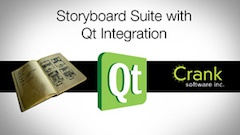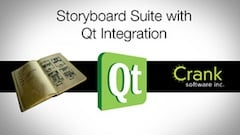 Storyboard was created to be a portable and platform agnostic solution. This allows us to give the same experience across Linux, QNX, Green Hills and so on. We often get asked how we deal with or compete with Qt. We see Qt as a platform abstraction layer like all of our other systems, it just happens to have an optional graphics component.
Storyboard was created to be a portable and platform agnostic solution. This allows us to give the same experience across Linux, QNX, Green Hills and so on. We often get asked how we deal with or compete with Qt. We see Qt as a platform abstraction layer like all of our other systems, it just happens to have an optional graphics component.
Recently we have been looking into how Storyboard could integrate into or communicate with a Qt based application. Storyboard gives UI developers and designers an extremely fast and efficient way to build modern HMI solutions (you can see an example here of how Storyboard differs from QML for UI Development). This solution is cross platform and extremely small and efficient. Users of Qt are also generally building cross platform applications and using QtGui may not be an option due to memory and performance concerns. Storyboard can be used in conjunction with Qt in order to solve these problems and still give the developer a cross platform solution.
One option to integrate Storyboard and Qt is to run Storyboard as a Qt widget. This allows Storyboard content to be displayed and interacted with onscreen with any other Qt based widget elements.
Another option allows users to remove the QtGui component and use Storyboard for the entire UI. This will also have the benefit of saving memory and increased performance. In this option Storyboard is run as the user interface and a non-GUI Qt application is written to preform backend logic. The Qt application can then communicate with Storyboard using a Qt/Storyboard IO bridge allowing data and events to seamlessly be transferred between the 2 environments.
As can be seen Storyboard and Qt are not a mutually exclusive solution, they can work together. I think Qt users will find that Storyboard gives them a rich visual design tool and will help speed their designs to market while still maintaining a cross platform application
.png?width=180&height=67&name=Crank-AMETEK-HZ-Rev%20(4).png)

